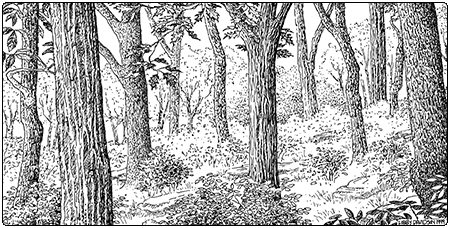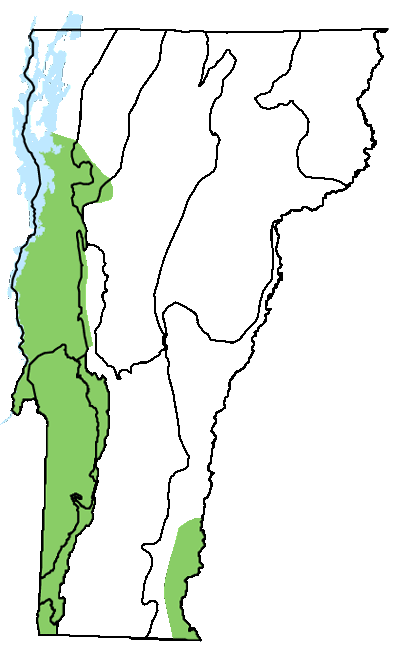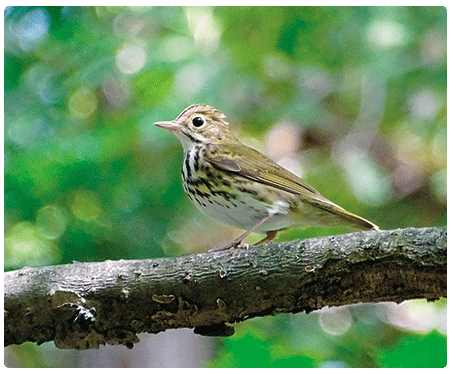Ecology and Physical Setting
With their abundant heath shrubs and southern oaks, Dry Oak Forests provide a welcome break from the ordinary when they are encountered after a hike up a hill in Vermont’s warmer regions. They can occur both as small patches, such as on a hilltop, or as larger patches sprawling across several hundred acres of rocky terrain. They are found at low elevations, mostly on acidic bedrock.
In Dry Oak Forests, bedrock is close to the surface, and nutrients are limited. The low rainfall and warmer climate in the biophysical regions where this community occurs, along with the low moisture-holding capacity of the soils, makes these relatively dry places. Water availability varies depending on the site. Flats tend to hold more moisture, supporting better tree growth, whereas ridgetops are usually very dry, limiting tree growth. Fire may play a role in some examples of this community. Gypsy moths can affect these forests, as they thrive on oak.
Vegetation
Overall diversity in Dry Oak Forests is low. Red oak and white oak are mixed in the canopy, and chestnut oak is occasional to abundant. Black oak occurs in this community in extreme southwestern Vermont, as well as in the lower Connecticut River valley. White pine is often present, but in low abundance. Trees range from tall and massive to short and poorly formed, but the canopy is nearly continuous. Tree form is tied to soil moisture: moister sites have taller, larger diameter trees, while drier sites can have scraggly, stunted trees.
Huckleberries and blueberries form dense thickets in the understory—walking through these thickets can be difficult but is rewarding during berry season. Herbs are sparse, but the occasional flowering wood lily, downy false foxglove, or four-leaved milkweed adds color to the forest floor.
Prior to the early 20th century, these forests would likely have also supported American chestnut. Some forests may have even been dominated by chestnut—the large-diameter, tall trees would have been an impressive sight. Today, because of the non-native chestnut blight fungus, mature chestnuts are almost entirely gone from Vermont’s forests, though they persist as saplings. The rot-resistant stumps and logs are the only indicators of this species’ former glory.
Wildlife Habitat
Dry Oak Forests provide abundant food for wildlife. Black bears, squirrels, chipmunks, and turkeys all rely on the calorie-rich acorns produced in the fall. During the summer, blueberries and huckleberries provide food for black bears, foxes, coyotes, and birds such as cedar waxwings. Nesting birds include eastern wood pewee, hermit thrush, scarlet tanager, and ovenbird. Two invertebrates rely on the heath family shrubs that are common in Dry Oak Forests. Blueberries and huckleberries are host plants for the uncommon brown elfin butterfly, and are some of the primary sources of pollen for the Carolina andrena bee. In the limited areas of Vermont where they occur, the rare eastern ratsnake and timber rattlesnake hunt in these forests for small mammals and birds.
Successional Trends
These oak forests are stable over time, especially on ridgetops prone to droughts. Fire may play a role in maintaining this community. For a variety of reasons, many eastern oak forests were burned by Native Americans. Researchers looking broadly at eastern oak forests (Nowacki and Abrams, 2008) have proposed that in the absence of fire, the accumulated leaf litter traps moisture and hinders oak regeneration, leading to a positive-feedback cycle of “mesophication” that ultimately results in a new community dominated by shade-tolerant, mesic-forest species. In Vermont, however, some of the best examples of Dry Oak Forest have abundant oak regeneration and no evidence of recent fire, suggesting that other processes besides fire can maintain these forests.
Related Communities
- Dry Oak-Hickory-Hophornbeam Forest has more nutrient-rich soils supporting higher diversity. Maple and hickory are mixed in with the oaks. Chestnut oak is absent from this community.
- Dry Chestnut Oak Woodland has a similar species composition, but chestnut oak is typically dominant and dry site grasses are abundant. Heath shrubs are sparse. The increased droughtiness of the soils reduces canopy cover significantly.
- Dry Red Oak-White Pine Forest shares many species but lacks the more southern species such as chestnut oak and white oak.
Conservation Status and Management Considerations
This community is somewhat uncommon in Vermont, but a few good examples are found on protected lands. A number of high quality examples are found in fragmented landscapes and are threatened by development. The use of prescribed fire may have unintended negative impacts and is not recommended.
Distribution/Abundance
Dry Oak Forest is occasionally found on acidic ridgetops in the Champlain Valley, Taconic Mountains, and Connecticut River valley. Similar communities are found more commonly to our south, where they can be widespread on ridges and other dry sites.
Characteristic Plants
Trees
Abundant Species
Red oak – Quercus rubra
White oak – Quercus alba
Occasional to Locally Abundant Species
White pine – Pinus strobus
Chestnut oak – Quercus montana
Black oak – Quercus velutina
Shrubs
Abundant Species
Huckleberry – Gaylussacia baccata
Low sweet blueberry – Vaccinium angustifolium
Occasional to Locally Abundant Species
Common shadbush – Amelanchier arborea
Witch hazel – Hamamelis virginiana
American chestnut – Castanea dentata
Early azalea – Rhododendron prinophyllum
Fragrant sumac – Rhus aromatica
Herbs
Abundant Species
Poverty grass – Danthonia spicata
Hairgrass – Deschampsia flexuosa
Occasional to Locally Abundant Species
Cow-wheat – Melampyrum lineare
Broad-leaved sedge – Carex platyphylla
Bottle-brush grass – Elymus hystrix
Marginal wood fern – Dryopteris marginalis
Bracken fern – Pteridium aquilinum
Panicled hawkweed – Hieracium paniculatum
Four-leaved milkweed – Asclepias quadrifolia
Rare and Uncommon Plants
Slender wheatgrass – Elymus trachycaulus
Downy arrowwood – Viburnum rafinesquianum
Panicled tick-trefoil – Desmodium paniculatum
Squawroot – Conopholis americana
Flowering dogwood – Cornus florida
Lopsided rush – Juncus secundus
Large whorled pogonia – Isotria verticillata
Sassafras – Sassafras albidum
Spotted wintergreen – Chimaphila maculata
Violet bush-clover – Lespedeza violacea
Scarlet oak – Quercus coccinea
Wood lily – Lilium philadelphicum
Smooth false-foxglove – Aureolaria flava var. flava
Rattlesnake-weed – Hieracium venosum
Fragrant sumac – Rhus aromatica
Associated Animals

Eastern chipmunk – Tamias striatus
Eastern gray squirrel – Sciurus carolinensis
Southern flying squirrel – Glaucomys volans
Black bear – Ursus americanus
Wild turkey – Meleagris gallopavo
Eastern wood pewee – Contopus virens
Wood thrush – Hylocichla mustelina
Scarlet tanager – Piranga olivacea
Ovenbird – Seiurus aurocapilla
Carolina andrena bee – Andrena carolina
Rare and Uncommon Animals
Eastern ratsnake – Pantherophis alleghaniensis
Timber rattlesnake – Crotalus horridus
Northern long-eared bat – Myotis septentrionalis
Brown elfin – Callophrys augustinus
Places to Visit
Fort Dummer State Park, Brattleboro and Guilford, Vermont Department of Forests, Parks, and Recreation
Snake Mountain, Addison, Vermont Department of Fish and Wildlife
North Pawlet Hills Natural Area, Pawlet, The Nature Conservancy
